
Total solar eclipse confirms path of progress
By Gov. Janet Mills and Joan Ferrini-Mundy
From Bonnie Tyler’s 1983 pop lyrics to ancient prophecies of the end of days, the idea that the center of our solar system could be blocked from view, the mid-day sky darkened as if night, the temperature lowered, and animals, insects and birds silenced and scattered, has fascinated and frightened humankind for centuries. It is as if, for a few moments, a magician has taken charge of the universe and our sense of time suspended.
But a total eclipse is not just a tourist attraction but a phenomenon which carries great scientific significance, one that confirmed certain principles that underlie nearly every scientific concept of the past one hundred years — even the birth of the universe.
Here’s how.
A total eclipse is the one and only time that scientists can detect the bending of light by the force of gravity emanating from the enormous mass of the sun, which is 300,000 times larger than our earth. For this reason, more than a century ago, world-renowned astronomers and “eclipse chasers” travelled to the far ends of the globe in order to view and photograph a clear picture of a total eclipse of the sun.
What were they trying to prove? Nothing less than Albert Einstein’s theory of general relativity.
Einstein changed scientists’ views of the relationship between energy, matter, space, and time. Intrepid astronomers, clock-makers, and photographers braved unpredictable weather, difficult terrain in remote territories, and even war to obtain the first observed evidence for Einstein’s theory by witnessing the “astonishing splendor of a total solar eclipse.”
Total solar eclipses provided, in Einstein’s view, the perfect opportunity for obtaining photographs of stars that would help answer the question “How much weight does light have?” and ultimately prove his Theory of General Relativity.
Only during a total eclipse could early 20th century scientists photograph the glow of stars around the sun, then compare photos of those same stars on a normal night to show them appearing in slightly different places. Proof that the stars looked to be in different places showed that light was affected by gravity.
Published on the 100th anniversary of this 1919 discovery, “Proving Einstein Right,” by popular Maine author Cathie Pelletier and noted theoretical physicist S. James Gates Jr., is a compelling, well-researched history of total solar eclipses and of those who sought to confirm Einstein’s theory. Re-reading this book recently made us feel better prepared as our state falls under the path of a total eclipse on April 8.
Thinking about the impact of that discovery over a century ago, a story of persistence and grit, trying and failing and trying again and finally succeeding, is an awe-inspiring history of scientific discovery, as these “eclipse chasers” endured travel in strange climes and remote places, all in the course of the development of modern science. It is in that same spirit that scientists today also bring together skilled teams, assemble the right tools, and invent processes to get data, all with the same curiosity and drive to help us better understand our world.
Today we can thank those bold explorers and Einstein’s theories of relativity for the development of GPS navigation, for electric generators, and even an explanation of the color of gold.
Today’s era of multimessenger astrophysics produced the Nobel Prize-winning direct observation in 2016 of gravitational waves and the first direct image of a black hole in 2019 — once again: scientists using the most advanced technologies of the day to communicate across continents to record observations, make discoveries, and verify theories.
Gates and Pelletier remind us that eclipses will continue to fascinate humans for a long time to come, which is why planetariums such as the Versant Power Astronomy Center at the University of Maine are helping us understand this phenomenon.
On April 8, as we are transfixed by the darkening afternoon sky, let us remember that it was a total eclipse of the sun that transformed modern science and that made Albert Einstein himself a superstar.
Mills is the governor of Maine. Joan Ferrini-Mundy is the president of the University of Maine.